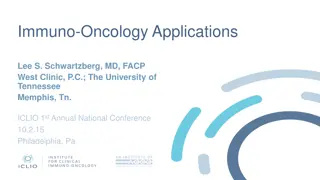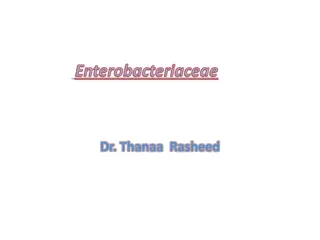Immune-deficiencies
Immune deficiencies can be classified into primary hereditary disorders based on clinical presentations, including cell-mediated, antibody-mediated, non-specific, and complement activation deficiencies. Major clinical manifestations of immune disorders range from B-cell deficiencies to phagocytic ce
2 views • 46 slides
INTRODUCTION OF IMMUNOLOGY
Explore the fundamentals of immunology with insights into immunogens, antigens, epitopes, and haptens. Uncover how these key components play vital roles in shaping immune responses and learn about paratopes, the basis of immunogenicity, and the key events that determine foreignness in the immune sys
0 views • 15 slides
Understanding Human Blood Groups and Genetics
Human blood groups are determined by the presence or absence of specific antigens and antibodies. The ABO system categorizes blood into four types (A, B, AB, O), while the Rh factor (D antigen) determines whether blood is RhD positive or negative. Blood group antigens are crucial for safe transfusio
2 views • 14 slides
Human Immunodeficiency Virus
HIV, a member of the lentivirus subfamily of retroviruses, causes Acquired Immunodeficiency Syndrome (AIDS). HIV-1 and HIV-2 have distinct characteristics, with HIV-1 being global and HIV-2 primarily in West Africa. The virus encodes reverse transcriptase and has an envelope containing glycoproteins
1 views • 31 slides
Understanding Blood Groups and Their Significance
Human blood types are determined by specific antigens and antibodies present on red blood cells, influencing crucial aspects like blood transfusions and familial relationships in forensic medicine. The ABO system, with its four main blood types (A, B, AB, O), plays a vital role in categorizing blood
7 views • 14 slides
Understanding Active vs. Passive Immunity for Better Health
Immunity is the body's defense mechanism against diseases. Active immunity occurs through exposure to antigens, either naturally during infection or artificially through vaccines. It leads to the production of memory cells for long-lasting protection. On the other hand, passive immunity involves rec
0 views • 17 slides
Comprehensive Guide to Immune System Glossary Terms
Dive into the world of immune system glossary terms with definitions and visual aids. Explore key concepts such as immune cell activation, adaptive immune response, antibodies, antigens, and more. Understand the complex processes within the immune system through informative images and concise explan
1 views • 70 slides
Understanding CareStart COVID-19 Antigen Test Procedures and Safety Measures
This overview delves into the CareStart COVID-19 antigen test, touching on its approval status, intended use, safety precautions, how the test works, proper disposal and cleanup methods, and the importance of Personal Protective Equipment (PPE) during testing. The test involves specific procedures w
0 views • 18 slides
Understanding Immunoassay of Digoxin in Pharmaceutical Sciences
Immunoassay is an analytical method utilizing specific antibody-antigen reactions to determine reactant amounts. This method involves competitive binding between labeled and unlabeled analytes and specific antibodies. Antibodies, antigens, labels, and separation matrices play crucial roles in immuno
0 views • 29 slides
Overview of Viral Gastroenteritis: Etiology, Epidemiology, Clinical Features, Diagnosis, and Treatment
Viral gastroenteritis is an inflammation of the gastrointestinal tract primarily affecting the stomach and small intestine, leading to symptoms like acute diarrhea and vomiting. It can be caused by various infectious agents such as Rotavirus, Adenovirus, Caliciviruses, Astrovirus, Coronavirus, Torov
1 views • 7 slides
Understanding Antigens and Immunogens: Types and Properties
Antigens are substances that stimulate the production of antibodies in the body, exhibiting specificity in immune reactions. They interact with immune response products like antibodies, BCRs, and TCRs. Immunogens induce detectable immune responses, leading to antibody production or T cell activation
1 views • 30 slides
Understanding Monoclonal Antibodies in Medical Treatment
Monoclonal antibodies are created using hybridoma cells that can produce specific antibodies and divide rapidly. These antibodies, which target specific antigens, have various applications in medicine, such as in cancer treatment and pregnancy tests. By harnessing the immune system's abilities, mono
1 views • 19 slides
Klebsiella Species: Characteristics and Pathogenicity
Klebsiella species, such as K. pneumoniae and K. oxytoca, are gram-negative bacilli commonly found in the microbiota of the intestines, nasopharynx, and feces. They exhibit distinct characteristics like pink mucoid colonies on MacConkey's agar and are known to cause both community-acquired and hospi
0 views • 24 slides
Understanding Proteus Bacteria: Historical Significance, Pathogenesis, and Laboratory Diagnosis
Proteus species, named after the Greek god Proteus, exhibit pleomorphism. Their historical importance stems from the unique characteristics of H and O antigens, with flagellated strains resembling a thin film on agar. Pathogenically, Proteus mirabilis and P. vulgaris are opportunistic pathogens caus
0 views • 12 slides
Understanding Antigen-Antibody Precipitation Reaction in Microbiology
Antigen-antibody precipitation reaction involves the formation of insoluble products when a soluble bivalent antibody interacts with a soluble antigen. This reaction leads to the formation of a visible precipitate known as a lattice. The mechanism of precipitation, including the prozone phenomenon,
0 views • 20 slides
Understanding Inflammation and Repair in Tissue Response
Inflammation is a crucial process in response to tissue injury, aiming to eliminate harmful agents and promote healing. It involves vascular changes, increased permeability, and the formation of edema. Repair follows inflammation, involving regeneration and fibroblastic tissue formation. While infla
0 views • 57 slides
Understanding Agglutination Reactions in Immunology
Agglutination reaction is a key technique in immunology where particulate antigens and antibodies clump together in the presence of electrolytes. This reaction is highly sensitive and often used for antibody detection, bacterial identification, blood grouping, and cross-matching. The process involve
0 views • 20 slides
Understanding Antibody-Mediated Immunity in Humoral Immunity
This content delves into the mechanisms of antibody-mediated immunity, focusing on B-cells as key players in humoral immunity. It covers topics such as activation of B-cells, clonal selection, generation of plasma and memory cells, primary and secondary immune responses, and the structure and functi
0 views • 20 slides
Understanding Antigens and Immunogenicity in Immunology
Learn about antigens, immunogenicity, antigenicity, and epitopes in immunology. Antigens are substances with distinct immunologic properties, while immunogenicity refers to the ability of an antigen to induce an immune response. Antigenicity is the ability of an antigen to combine specifically with
0 views • 41 slides
Understanding Complement Fixation Test (CFT) in Immunology
Complement Fixation Test (CFT) is a key immunological method used to detect specific antibodies in a patient's serum by using complement proteins. This test involves the stages of incubation with antigens, inactivated serum, and complement, followed by the indicator stage using sheep red blood cells
1 views • 17 slides
Viral Specimen Selection and Collection Overview
Specimen selection for viral testing depends on the suspected viral etiologies and disease syndrome. Throat and nasopharyngeal swabs are used for different viruses, while rectal swabs, urine, blood, and tissue samples are also collected for specific viral detection. Proper specimen transport and sto
0 views • 7 slides
Understanding Immunity: Types and Functions Explained
Immunity is the body's defense mechanism against pathogens, encompassing innate and acquired immunity. It involves resistance to infections and foreign antigens, inherited or acquired. Innate immunity provides the first line of defense, while acquired immunity can be active or passive. Species immun
0 views • 33 slides
Understanding ABO Blood Grouping and Rh Groups
ABO blood grouping and Rh factor testing are crucial for blood transfusions and forensic medicine. The presence or absence of specific antigens and antibodies in human blood determines blood type. Genetic inheritance from parents establishes blood type, with codominance influencing offspring phenoty
0 views • 13 slides
Why Do We Match Blood for Patients?
Blood matching for patients is crucial to prevent adverse reactions like hemolysis and death. ABO and RhD compatibility testing are fundamental, along with selecting antigen-negative units for patients with clinically significant antibodies. Beyond mandatory requirements, matching can be complex due
0 views • 9 slides
Understanding Proteus Species: Morphology, Cultural Characteristics, and Antigenic Structure
Proteus species, specifically P. mirabilis and P. vulgaris, are important opportunistic pathogens in human infections. They exhibit unique characteristics such as swarming growth on agar, gram-negative coccobacilli morphology, and distinctive antigenic structures with O and H antigens. The swarming
2 views • 25 slides
Immune Response Regulation and Autoimmunity Overview
The immune system maintains a balance through tolerance mechanisms to prevent autoimmunity. Central and peripheral tolerance play crucial roles in immune unresponsiveness to self-antigens. Failure in immune regulation can lead to autoimmune diseases like diabetes and lupus. Vaccination, discovered b
0 views • 18 slides
Understanding Donor-Specific Antibodies in Kidney Transplantation
Antibodies against antigens in the major histocompatibility complex play a crucial role in kidney transplant rejection. Different types of donor-specific antibodies can lead to rejection at various stages post-transplantation. Methods to discover donor-specific anti-HLA antibodies include complement
0 views • 16 slides
Understanding Hypersensitivity Reactions in Immunology
Hypersensitivity in immunology refers to an altered immune response against antigens, leading to hyperreactivity and immunopathology. This article delves into the different categories of adaptive hypersensitivities, focusing on Immediate (Type I), Antibody-Mediated Cytotoxic (Type II), and Immune Co
0 views • 6 slides
Understanding Hypersensitivity Reactions and Classification
Hypersensitivity reactions occur in sensitized hosts following contact with specific antigens, leading to injurious consequences. The Gell and Coombs Classification categorizes reactions into Type I, II, III, and IV based on immune response and duration. Type I reactions are immediate and humoral, w
0 views • 30 slides
Understanding Antibodies: Structure, Functions, and Applications
Explore the structure and functions of antibodies, including how they bind to antigens, act as opsonins, agglutinins, and anti-toxins. Learn about the specificity of antibodies, their variable regions, and their role in neutralizing pathogens and viruses. Gain insights into how antibodies help the i
1 views • 17 slides
Agglutination Testing in Laboratory Medicine
Agglutination testing is a common method used in laboratory medicine to detect the presence and amount of antigens or antibodies in patient samples. It involves the use of carrier particles such as latex, RBCs, charcoal, and protein A of Staph aureus. The testing process includes qualitative and qua
0 views • 18 slides
Understanding Cryptococcal Immune Reconstitution Inflammatory Syndrome
Cryptococcal Immune Reconstitution Inflammatory Syndrome (C-IRIS) is a condition where rapid reversal of immunodeficiency triggers exaggerated inflammatory reactions in response to Cryptococcus antigens. It can manifest as either Unmasking IRIS or Paradoxical IRIS, with common CNS presentations incl
0 views • 10 slides
Understanding Avian Influenza: Symptoms, Diagnosis, and Prevention
Avian influenza, or bird flu, is a viral disease affecting birds' respiratory, digestive, and nervous systems. It presents in two forms - Highly Pathogenic Avian Influenza Virus (HPAIV) and Low Pathogenic Avian Influenza Virus (LPAIV). The virus has two important surface antigens, Hemagglutinin (H)
0 views • 7 slides
Evolution of Immunotherapy in Cancer Treatment
The history and advancements in cancer immunotherapy are highlighted, from early observations in the 1890s to the development of modern immunotherapies in the 2000s. Concepts such as immunosurveillance theory and the role of T cells in recognizing tumor-associated antigens are discussed, leading to
0 views • 22 slides
Overview of Enterobacteriaceae Family and Their Antigenic Structure
The Enterobacteriaceae family comprises a diverse group of gram-negative rods commonly found in the gut of humans and animals, known for causing various diseases. Key members include Escherichia coli, Shigella, Salmonella, Klebsiella, and more. They are facultative anaerobes, ferment glucose, lack c
0 views • 48 slides
Understanding Streptococci: Classification and Characteristics
Streptococci are Gram-positive cocci commonly found in chains or pairs. This article covers their classification based on hemolysis patterns and Lancefield grouping, along with general characteristics and principles of differentiation tests. Learn about the infections caused by different Streptococc
0 views • 39 slides
Understanding ELISA Techniques in Cellular and Molecular Pharmacology
ELISA (Enzyme-Linked Immunosorbent Assay) is a vital immunological technique used in detecting antigens or antibodies in samples. This article covers the types of ELISA tests, such as Direct, Indirect, and Sandwich, along with the principles and applications of ELISA in diagnosis. The process involv
0 views • 18 slides
Overview of Immunohistochemistry (IHC) in Diagnostic and Research Laboratories
Immunohistochemistry (IHC) is a technique used to detect antigens in tissue sections by utilizing antibodies that bind specifically to target antigens. This method has evolved since the 1930s and plays a vital role in disease diagnosis, drug development, and biological research. IHC combines anatomi
0 views • 19 slides
Understanding ELISA: Principle, Types, and Applications
ELISA (enzyme-linked immunosorbent assay) is a widely used laboratory technique for detecting and quantifying antigens or antibodies in blood samples. Introduced in 1971, ELISA involves an antigen-antibody reaction using enzyme-conjugated antibodies to generate a colored product on a plate. There ar
1 views • 14 slides
Understanding Antigen-Antibody Precipitation Reaction in Immunity
The humoral basis of immunity involves the specific reaction between antigens and antibodies, resulting in the formation of insoluble precipitates through a process called precipitation. This reaction plays a crucial role in immune responses against infectious diseases, influenced by factors like af
0 views • 16 slides







































